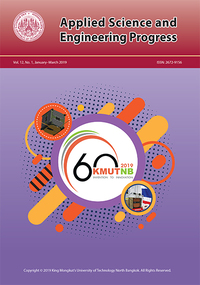Development of a Walnut (Tetracarpidium conophorum) Cracker
Main Article Content
Abstract
The emerging knowledge of the use and importance of African walnut (Tetracarpidium conophorum) for different purposes has made the study for the development of walnut cracker imperative. A cracker for walnut was designed, constructed and evaluated. The major components of the machine are the cracking and cleaning units. The cracking of the walnuts to bring out the needed oily seeds is achieved through the compressive and shearing actions between the two abrasive drums when the nuts fell in between them, while the cleaning unit has a centrifugal fan that separates the seed from the cracked shells via air velocity. The performance evaluation of the machine was carried out using four levels of cracking drum speeds (280, 310, 340, and 370 rpm) and fan speeds (1200, 1400, 1600, and 1800 rpm); also two levels of feed rates (32 and 42 kg/h) and moisture content (10.3 and 17.6%wb). The results obtained showed that; on the average, the machine had a cracking efficiency of 92.63%, cleaning efficiency of 95.48%, percentage seed loss of 5.93%, mechanical damage index of 11.06%, throughput of 21.05 kg/h and cracker performance index of 88.3%. The power requirement for operating the machine is 1.68 kW. With this newly developed walnut cracker, full exploitation of the nutritional, industrial and medicinal potential of the walnut seed will be enhanced.
Article Details
References
[2] P. B. Ayoola, O. O. Onawumi, and O. O. P. Faboya, “Chemical evaluation and nutritive values of Tetracarpidium conophorum (Nigerian walnut) seeds,” Journal of Pharmaceutical and Biomedical Sciences, vol. 11, no. 15, pp. 1–5, 2011.
[3] V. N. Enujiugha, “Chemical and functional characteristics of Conophor nut,” Pakistan Journal of Nutrition, vol. 2, no. 6, pp. 335–338, 2003.
[4] S. N. Asoegwu, “Some physical properties and cracking energy of Conophor nuts at different moisture content,” International Agrophysics, vol. 9, no. 2, pp. 131–142, 1995.
[5] A. Ghafari, G. R. Chegini, J. Khazaei, and K. Vahdati, “Design, construction and performance evaluation of the walnut cracking machine,” International Journal of Nuts and Related Science, vol. 2, no. 1, pp. 11–16, 2011.
[6] C. N. Asota, “Cowpea/Soybean’s shelling principles and practice,” in Proceedings of a Common wealth sponsored Workshop on Technology, Tools and Processes for Women, 1996, pp. 111.
[7] M. Dasso, “Design, construction and testing of a walnut cracker,” M.S. thesis, Department of Bioresource and Agricultural Engineering, Faculty of BioResource and Agricultural Engineering, California Polytechnic State University, California, USA, 2012.
[8] M. C. Ndukwu and C. Ejirika, “Physical properties of wild persian walnut (Juglans regia L.) from Nigeria,” Cogeent Food & Agriculture, vol. 2, no. 1, pp. 1–11, 2016.
[9] F. A. Oluwole, M. B. Oumarou, and G. M. Ngala, “Dynamics of centrifugal impact nut cracker,” International Journal of Research Studies in Science, Engineering and Technology, vol. 3, no. 1, pp. 15–21, 2016.
[10] N. A. Aviara and J. O. Ajikashile, “Effect of moisture content and loading orientation on some strength properties of conophor (Tetracarpidium conophorum) nut,” Agricultural Engineering Research Journal, vol. 1, no. 1, pp. 4–11, 2011.
[11] R. S. Khurmi and J. K. Gupta, Theory of Machines. New Delhi, India: S. Chand, 2006, pp. 440–455.
[12] O. H. Park, Metals Hand Book, 10th ed., Geauga, Ohio: ASM International, 1990, pp. 10–12.
[13] W. C. Osborne, Fans: (In SI/Metric Units) (International Series in Heating, Ventilation and Refrigeration; v.1). Oxford, England: Pergamon Press, 1977.
[14] S. M. Henderson and R. L. Perry, Agricultural Process Engineering. New York :John Wiley & sons Inc., 1955, pp. 108–127.
[15] E. S. Bosoi, O. V. Verniaev, E. G. Smirnov, and E.G. Sultan-Shakh, Theory, Construction and Calculations of Agricultural Machines. New Delhi, India: Amerind Publishing, 1991.
[16] F. A. Oluwole, N. A. Aviara, and M. A. Haque, “Development and performance tests of a shea nut cracker,” Journal of Food Engineering, vol. 65, no. 1, pp. 117–123, 2004.
[17] O. O. Fasina and O. O. Ajibola, “Mechanical expression of oil from conophor nut (Tetracarpidium conophorum),” The Journal of Agricultural Engineering, vol. 44, no. 4, pp. 275–287, 1989.
[18] National Centre for Agriculture Mechanization, “Draft Nigerian standard test code for grain threshers,” N.C.A.M., Ilorin, Nigeria, 1998.
[19] A. F. Alonge and M. Idung, “Development of a bush mango (Irvingia gabonensis) nut cracker,” Agricultural Engineering International: CIGR Journal, vol. 17, no 2, pp. 191–199, 2015.
[20] A. A. Atiku, N. A. Aviara, and M. A. Haque, “Performance evaluation of a bambara groundnut sheller,” Agricultural Engineering International: The CIGR Journal of Scientific Research and Development, vol. 6, pp. 1–18, Jul. 2004.
[21] G. M. Bedane, M. L. Gupta, and D. L. George, “Development and evaluation of a guyale seed harvester,” Industrial Crops and Products, vol. 28, pp. 177–183. 2008.
[22] P. C. Onyechi, S. P. Obuka Nnaemeko, C. Okpala V. N. Oriah, and C. A. Igwegbe, “Design enhancement evaluation of a castor seed shelling machine,” Journal of Scientific Research and Report, vol. 3, no. 7, pp. 924–939, 2014.
[23] S. J. Ojolo, O. Damisa, J. I. Orisaleye, and C. Ogbonnaya, “Design and development of cashew nut shelling machine,” Journal of Engineering, Design and Technology, vol. 8, no. 2, pp. 146–157, 2013.


